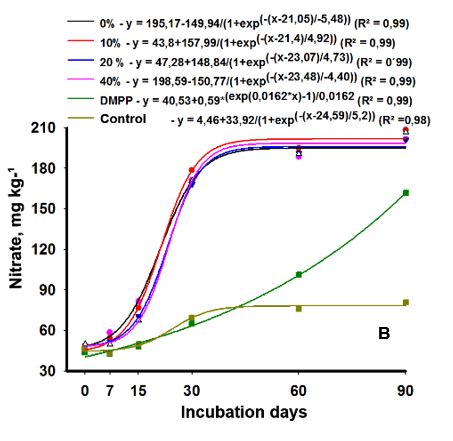A Efficiency of neem (Azadirachta indica) as a nitrification inhibitor under laboratory conditions
DOI:
https://doi.org/10.52755/sas.v4i2.199Keywords:
Nitrogen, Nutrient Management, ureaAbstract
The use of nitrification inhibitors is a technology that can increase the efficiency of nitrogen fertilization, and synthetic and natural products can be used for this purpose. However, the use of these products is still poorly studied in tropical regions. The objective of this work was to evaluate the nitrification of nitrogen, under laboratory conditions, with urea covered with doses of neem leaf or cake, using DMPP (3,4-dimethylpyrazole phosphate) for comparison. The treatments consisted of a 2 x 4 + 2 factorial scheme, with the first factor represented by neem sources (leaf and cake), used to cover the urea and the second factor by neem doses, these doses being 0, 10 , 20 and 40% of the total applied N (200 mg kg-1, using urea as a N source) and two additional treatments: control (soil without nitrogen fertilizer) and urea + DMPP. Ammonium and nitrate contents were evaluated right after incubation (time 0) and on the 7th, 15th, 30th, 60th and 90th day after the start of incubation. For the ammonium content in the soil, there was influence of source and dose on the fifteenth day of incubation, with linear increments for both sources; and for nitrate levels, there was a significant effect (p<0.01) of neem doses on the 7th and 15th days of incubation, with a reduction in levels depending on the doses for the two sources tested. Significant differences (p<0.01) were found between additional and factorial treatments and between additional treatments for ammonium levels from the 7th to the 90th day of incubation. There was no significant interaction, in any of the dates, between neem sources and doses for ammonium and nitrate contents in the soil. Covering the urea with neem leaf and cake was efficient in reducing the levels of nitrate in the soil up to 15 days after incubation, resulting in higher levels of ammonium in the soil until this date. However, DMPP was more efficient in reducing nitrification, promoting inhibition up to 60 days of incubation.
Downloads

Downloads
Published
How to Cite
Issue
Section
License
Copyright (c) 2024 Edimar Rodrigues Soares, Edson Luiz Mendes Coutinho, Esmeralda Ochoa Martínez, Marcio Silveira da Silva, Marilena de Melo Braga, Fábio Tiraboschi Leal, José Eduardo Corá, Joao Wesley Rezende

This work is licensed under a Creative Commons Attribution-NonCommercial-ShareAlike 4.0 International License.
Autores concordam com os seguintes termos:
a) Os autores mantêm os direitos autorais e concedem à revista o direito de primeira publicação, com o trabalho simultaneamente licenciado sob a LicençaAttribution-NonCommercial-ShareAlike 4.0 International, que permite o compartilhamento do trabalho com reconhecimento da autoria e publicação inicial na Revista SAS. A licença permite o uso, a distribuição e a reprodução irrestrita, em qualquer meio, desde que devidamente citada a fonte. Essa licença permite também que outros remixem, adaptem e criem a partir do seu trabalho para fins não comerciais, desde que atribuam a você o devido crédito e que licenciem as novas criações sob termos idênticos.
b) Não cabe aos autores compensação financeira a qualquer título, por artigos ou resenhas publicados na South American Sciences.
c) Os conceitos expressos nos artigos publicados na South American Sciences são de inteira responsabilidade de seus autores.








